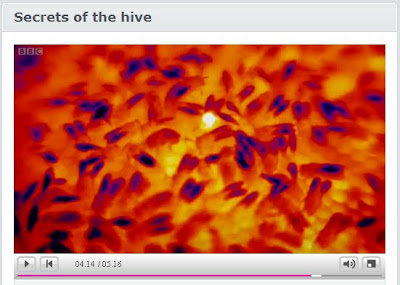Edited extract from http://www.bbc.co.uk/programmes/p007vrx7
Seen in the visible spectrum, all bees may look the same. In the infra-red spectrum, it is clear that some bees are warmer than others. Some glow bright orange like hot coals, radiating heat to their surroundings. Others are dark and cool.
Seen in the visible spectrum, all bees may look the same. In the infra-red spectrum, it is clear that some bees are warmer than others. Some glow bright orange like hot coals, radiating heat to their surroundings. Others are dark and cool.
Heat is concentrated in one central area of the hive, the brood nest, where young bee pupae are growing. A bee that may appear relatively still, when looked at in infra-red is glowing bright orange, revealing its role as a specialist heater bee.
The bee warms itself up by vibrating its flight muscles - vibrations that allow it to warm up to 44 degrees centigrade, previously thought to be high enough to kill it. Others that seem to be grabbing a quiet snooze are actually tight little balls of fire that are acting to keep the brood warm.
More than two thirds of the hive's honey goes on the central heating of the colony. A rarely seen moment is caught on camera when an exhausted heater bee is topped up by a refuelling bee just returned from foraging.
By controlling the temperature, heater bees control the destiny of the young. Incubated at 34 degress, the newly born bees are likely to become humble housekeepers, but kept just one and a half degrees warmer, they may instead turn into intelligent and high-ranking foragers, living up to 10 times longer.

1 comment:
The first thing I learned is that there are lots of great beekeeping starter kits out there to help you begin if you're a total novice. You don't need to be Johnny Bee! Obviously you're going to need honeybees, but before that happens you'll need to find a hive. I liked the idea of a bee hive starter kit because these will usually come with most if not all of the tools which you'll need, including the hive body, the frames which go inside, a bee smoker to calm the bees when you extract the honey, protective gear like gloves and face mask, and so on.
bee hives for sale
Post a Comment